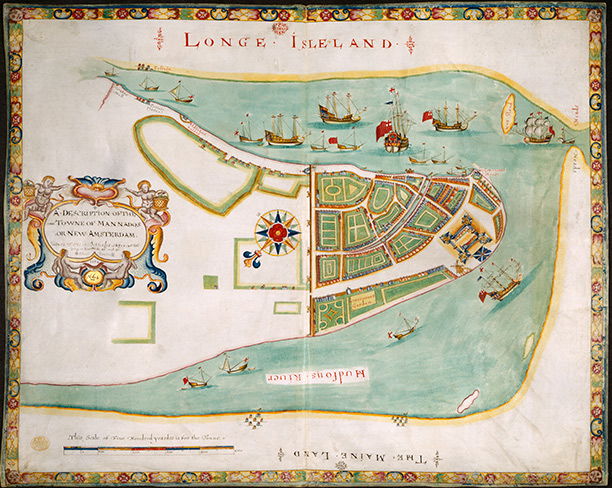New Amsterdam surrendered to the English
Manhattan was taken on September 8th, 1664.
 New York City started its glittering history in a modest way as the Dutch settlement of New Amsterdam. The story begins in 1609 when Henry Hudson, an English sea captain working for Dutch merchants, was trying to find a north-west passage to Asia. Exploring along the Atlantic seaboard of North America, he came to the island of Manhattan and then sailed north for 150 miles or so up the river later named after him. Returning to Europe, he reported that there was a good prospect of profitable trading in furs there and in 1614 the Dutch established a trading post called Fort Nassau, later Fort Orange, near today’s city of Albany.
New York City started its glittering history in a modest way as the Dutch settlement of New Amsterdam. The story begins in 1609 when Henry Hudson, an English sea captain working for Dutch merchants, was trying to find a north-west passage to Asia. Exploring along the Atlantic seaboard of North America, he came to the island of Manhattan and then sailed north for 150 miles or so up the river later named after him. Returning to Europe, he reported that there was a good prospect of profitable trading in furs there and in 1614 the Dutch established a trading post called Fort Nassau, later Fort Orange, near today’s city of Albany.
The post had only a tiny Dutch population of some 50 traders and soldiers, but Dutch ships sailed regularly up the Hudson to collect furs and more Dutch expeditions explored the area, which became the colony of New Netherland, run by the Dutch West India Company. In 1625 the company founded New Amsterdam at the southern tip of Manhattan Island as the colony’s capital and seat of government, with a fort to protect it and guard the harbour and the precious fur cargoes against English or French raids. Peter Minuit of the Dutch West India Company, who was in charge from 1626, decided to buy Manhattan Island from a group of local Indians for goods worth 60 Dutch guilders, which later legend valued at US$24. It has been rated the best real estate deal in history.
As well as Dutch families, in time Jews, French Huguenots and other Europeans settled in New Amsterdam, which became a busy trading centre between North America, the Caribbean and Europe. Settlers started farming Manhattan Island, imported black Africans as slave labourers and began farming further up the Hudson Valley, on Long Island and across the river in today’s New Jersey.
A new colonial governor, Peter Stuyvesant, arrived to take charge in New Amsterdam in 1647. A former army officer and a commanding figure, he had previously governed the Caribbean island of Curaçao, where he lost his right leg to an enemy cannonball and had to limp about on a wooden leg for the rest of his life. The story goes that if anyone opposed him he would angrily stamp his wooden leg and bellow at them. He was a convinced Calvinist, hostile to Quakers, Lutherans and all other species of Protestants, and tried to have Jews and those who did not belong to the Dutch Reformed Church banned from the colony, but the company persistently overruled him. His arrogant ways did not make him popular, as time would tell.
The English had been building up their own trade with the New World, founding their own colonies in Virginia and New England. Some English from New England had infiltrated onto Long Island. Charles II decided to seize New Netherland, take over the valuable fur trade and give the colony to his younger brother James, Duke of York and Albany (the future James II). The details vary from one account to another, but on August 27th, 1664 three or perhaps four English warships carrying 300 or maybe 450 English soldiers arrived at New Amsterdam. Their commander was Richard Nicolls, who had been a cavalry commander on the Royalist side in the English Civil Wars and was now a trusted subordinate of the Duke of York. He sent a letter to Stuyvesant demanding New Amsterdam’s surrender and promising to protect the lives, property and freedom of all who accepted English rule. Stuyvesant tore the letter to shreds and ordered preparations for resistance, but it soon became all too clear that few of the city’s inhabitants had any intention of risking life and limb against the English and, indeed, the New English in Long Island were getting ready to fight on the English side.
Stuyvesant accepted the situation and early in September surrendered New Amsterdam to the English and swore allegiance to the Crown. Nicolls took over as governor-general of New Netherland and handled matters tactfully, shrewdly and to the general satisfaction of the colony’s people. New Amsterdam was renamed New York City and New Netherland became New York State. Stuyvesant went to the Netherlands to report in 1665 and then returned to New York City, where he spent his remaining years quietly at his farm, which was called the Bouwerij and left its name to the street now called the Bowery. When he died in 1672 he was buried there, at St Mark’s Church. The bust of him in the church was presented by Queen Wilhelmina of the Netherlands in 1912. The nearby Stuyvesant Street, Stuyvesant Square and the Bedford-Stuyvesant area of Brooklyn bear his name.